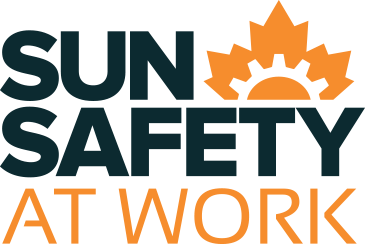Do-Support is the forth step of the Model Sun Safety Program. This step provides activities that support a workplace to implement control measures and help to manage risks from workplace hazards. These processes are used for the management of all workplace hazards, including sun safety.
First Aid and Incident Notification
Each jurisdiction’s OHS legislation includes requirements for first aid within the workplace. First aid procedures for sun safety depend on the health condition:
Sunburn: Workers should be removed from the sun. The skin should be cooled using cold compresses or by taking a cool shower. Moisturizing creams such as those containing aloe may be helpful. The sunburned areas should be covered to avoid further sun exposure. Workers should be encouraged to drink water and seek further medical advice for pain relief.
Photokeratitis (also known as snow blindness or welders flash): Cool wet compresses can be applied to the eyes. Anti-inflammation eye drops can be used. Pain relief medication may be helpful. The worker should recover in a dark location.
Heat stress: For heat rash and heat cramps, move the worker to a cool area, apply cool compresses, and provide fluid-replacement drinks such as water. For heat-related fainting and heat exhaustion, seek medical attention. Cool the person down by moving to a cool area, applying cool compresses and replacing lost fluids. Heat stroke is very serious and is a medical emergency. An ambulance should be called and actions taken to cool the worker.
If a sun exposure incident occurs, a written record of the incident and what first aid was provided should be made. This can be done in a first aid treatment record, or incident report. Supervisors/management and occupational health and safety coordinator should be notified.
Return to Work
Return to work is a process of safely returning employees to the workplace in a timely way, following an injury or health condition. The workplace will need to make an assessment of each individual’s situation, based on medical recommendations. If an employee is not able to directly return to their previous job, another suitable job or arrangements for a graduated return to work can be investigated.
For sun exposure incidents, the return to work processes will be dependent on the health condition. For sunburn and photokeratitis, these conditions fully resolve within a day or two. The worker should able to return to their job once the condition improves.
For a minor heat-induced condition, a worker may be able to return to work relatively soon and go back to their regular normal job tasks. However, for serious conditions such as heat stroke, the worker may take some time to recover. The worker may need a plan to gradually return to work or may need different job tasks.
Preventive Maintenance
Preventive maintenance makes sure that tools and equipment are safe to use.
This applies to all tools and equipment within a workplace. Any equipment or tools used to control sun exposure (for example, engineering controls such as canopies on tractors or portable shade structures, and personal protective equipment) should be included in the broader preventive maintenance program.
Procurement
Procurement is about procedures for evaluating and managing the purchasing and acquiring of products, supplies, equipment and materials. This helps to identify the best product for the intended purpose, and helps determine whether there are any hazards associated with these goods and what the risks are for use.
Any equipment or tools used to control sun exposure (for example, canopies on tractors, portable shade structures, personal protective equipment) should be included in the broader procurement program.
Sun exposure is seasonal – be mindful of when products or services need to be ordered so they there are available in time. Winter sun protection has different procurement needs (for example, enhanced solar UV eye protection in the winter).
Build Your Own Program Tips:
Resourcing
Work with the health and safety committee and management to get resources for new control measures or to update existing measures. The logistics of implementing new control measures can be challenging – buy-in and feedback from workers and management is important (for example, for sunscreen, hats, eyewear, long clothing, cool water).
The next step in the Model Sun Safety Program is Step 5: Check
Go back to Step 3: Do-Control Measures

